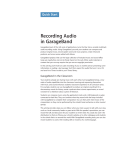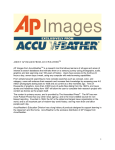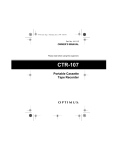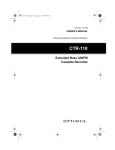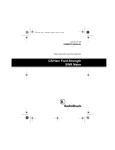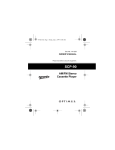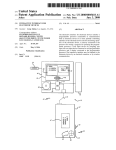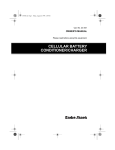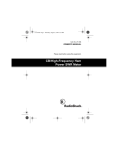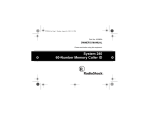Download Radio Shack 350 Owner`s manual
Transcript
20-209A.fm Page 1 Wednesday, August 4, 1999 8:36 AM Cat. No. 20-209A OWNER’S MANUAL Please read before using this equipment. DX-350 AM/FM/LW/SW1–9 12-Band Portable Receiver 20-209A.fm Page 2 Wednesday, August 4, 1999 8:36 AM INTRODUCTION Your RadioShack DX-350 is a 12-Band Portable Receiver for AM (MW), FM, long wave and worldwide shortwave broadcasts. Its nine shortwave bands put the world at your fingertips, with international broadcasts from Japan, Israel, England, Holland, Australia, and other countries around the globe. Because the receiver is so light and compact, you can carry it with you wherever you go. You can power it from any of three sources: internal batteries, standard AC, or vehicle battery power. To get the most enjoyment from your receiver, take a few minutes to completely read this manual before using the DX-350. FCC NOTICE Your receiver might cause radio or TV interference, even when it is operating properly. To determine whether or not your receiver is causing the interference, turn off your receiver. If the interference goes away, your receiver is causing the interference. Try to eliminate the interference by: • Moving your receiver away from another receiver • Connecting your receiver to an outlet that is on a different electrical circuit from the other receiver • Contacting your local RadioShack store for help If you cannot eliminate the interference, the FCC requires that you stop using your receiver. © 1997 Tandy Corporation. All Rights Reserved. RadioShack is a trademark used by Tandy Corporation. 2 20-209A.fm Page 3 Wednesday, August 4, 1999 8:36 AM CONTENTS Choosing a Power Supply ......................................................... Installing Batteries ................................................................. Using Standard AC Power ..................................................... Using a Vehicle Battery ......................................................... 4 4 5 6 Operation ..................................................................................... Tuning the Receiver .............................................................. Adjusting the Antennas ......................................................... Using Headphones ................................................................ Listening Safely .............................................................. Traffic Safety .................................................................. 7 7 7 8 8 9 Listening Guide ......................................................................... Band Allocation ................................................................... Ham Radio Frequencies ............................................... Time Standard Frequencies ......................................... International Radio Stations ......................................... Frequency Conversion ........................................................ 10 10 10 11 11 12 Care and Maintenance .............................................................. 13 Specifications ........................................................................... 15 3 20-209A.fm Page 4 Wednesday, August 4, 1999 8:36 AM CHOOSING A POWER SUPPLY You can power the receiver using either: • Four AA batteries • Standard AC power (with an optional AC adapter) • 12-volt DC vehicle power (with an optional DC adapter) INSTALLING BATTERIES You need four AA batteries (not supplied) to power your receiver. For the best results, we recommend alkaline batteries, such as RadioShack Cat. No. 23-552. Cautions: • Use only fresh batteries of the required size and recommended type. • Do not mix old and new batteries, different types of batteries (standard, alkaline, or rechargeable), or rechargeable batteries of different capacities. Illus cover removal, battery installation, and cover replacement 4 20-209A.fm Page 5 Wednesday, August 4, 1999 8:36 AM 1. Open the battery compartment by pushing the cover in the direction of the arrow. 2. Install four AA batteries in the battery compartment as indicated by the polarity symbols (+ and –) mark on the back of the receiver. Place the batteries on top of the ribbon so you can easily lift them out later. 3. Replace the cover. USING STANDARD AC POWER You can power the receiver from standard AC power with an AC adapter (such as Cat. No. 273-1454, not supplied). Insert the adapter’s small connector into the receiver’s DC 6V jack. Then plug the adapter into a standard AC outlet. Internal batteries automatically disconnect. Illustration of DC 6V jack w/adapter cord to AC outlet Caution: The recommended adapter supplies 6 volts DC and delivers at least 150 milliamps with its center tip set to negative. Using an adapter that does not meet these specifications could damage the receiver or the adapter. 5 20-209A.fm Page 6 Wednesday, August 4, 1999 8:36 AM USING A VEHICLE BATTERY With a DC adapter (such as Cat. No. 14-844, not supplied), you can operate the receiver in a car, boat, or recreational vehicle equipped with a 12-volt DC, negative-ground electrical system. Insert the adapter’s barrel plug into the receiver’s DC 6V jack. Set the adapter’s 6V/9V selector to 6V. Then plug the other end of the adapter into the vehicle’s cigarette-lighter socket. Internal batteries automatically disconnect. Cautions: • The recommended adapter supplies 6 volts DC and delivers at least 300 milliamps with its center tip set to negative. Using an adapter that does not meet the specifications could damage the receiver or the adapter. • Do not let the adapter’s barrel plug contact any metal parts of the vehicle when you plug the adapter into the lighter socket. This can damage the adapter or the vehicle’s electrical system. 6 20-209A.fm Page 7 Wednesday, August 4, 1999 8:36 AM OPERATION TUNING THE RECEIVER 1. To turn on the receiver, press POWER. 2. Set SW/LW/AM/FM to the desired band. For shortwave, also set SW BAND 1–9 to one of the bands from 1 to 9. See “Listening Guide” on Page 10 for more information about each band. 3. Adjust TUNING to tune to the desired station. The TUNING indicator lights when a station is tuned properly. 4. Set VOLUME to a comfortable listening level. ADJUSTING THE ANTENNAS For the best reception, adjust the antenna according to this chart. Band Frequency Range Antenna AM 535–1705 kHz Internal — Rotate the receiver for the best reception LW 150–281 kHz Internal — Rotate the receiver for the best reception FM 87.5–108 MHz Telescoping — Extend fully and swivel for the best reception SW 1–9 5.85–26.10 MHz Telescoping — Extend fully. do not swivel 7 20-209A.fm Page 8 Wednesday, August 4, 1999 8:36 AM USING HEADPHONES Sometimes headphones can capture the subtle difference between signals and the surrounding noise that often occurs at night. Be sure that the headphones (not supplied) have a 1/8-inch plug. Insert the plug into the jack on the left of the receiver. When you plug in the headphones, the speaker is silenced. You will find a wide selection of headphones at your local RadioShack store. Illustration of headphones jack location Listening Safely To protect your hearing, follow these guidelines when you use headphones. • Set the volume to the lowest setting before you begin listening. After you begin listening, adjust the volume to a comfortable level. • Do not listen at extremely high volume levels. Extended highvolume listening can lead to permanent hearing loss. • Once you set the volume, do not increase it. Over time, your ears adapt to the volume level, so a volume level that does not cause discomfort might still damage your hearing. 8 20-209A.fm Page 9 Wednesday, August 4, 1999 8:36 AM Traffic Safety Do not use headphones with your receiver when operating a motor vehicle or riding a bicycle in or near traffic. Doing so can create a traffic hazard and could be illegal in some areas. If you use headphones with your receiver while riding a bicycle, be very careful. Do not listen to a continuous broadcast. Even though some earphones/headphones let you hear some outside sounds when listening at normal volume levels, they still can present a traffic hazard. 9 20-209A.fm Page 10 Wednesday, August 4, 1999 8:36 AM LISTENING GUIDE Worldwide, there are thousands of shortwave listeners. The shortwave hobby can be very exciting. Newscasts of a country where important events are taking place give you a sense of immediacy and participation that reports on local stations cannot deliver. Being a shortwave listener requires no special knowledge. Random tuning is a good way to become acquainted with various bands and stations. But as you gain expertise, you will probably acquire special listening techniques. BAND ALLOCATION Certain portions of the radio frequency spectrum are set aside for specific purposes. Each range of frequencies is called a radio band. See “Specifications” on Page 15 for the band frequencies. The following sections list some of the most interesting band allocations. Ham Radio Frequencies Ham radio operators often broadcast emergency information when other means of communication break down. They use Morse code (called continuous wave) and single sideband. The following chart shows the continuous wave frequencies you can receive on the DX-350. The DX-350 cannot receive single sideband signals. 3,500–3,800 kHz 7,000–7,150 kHz 14,000–14,200 kHz 21,000–21,250 kHz 28,000–28,500 kHz 10 20-209A.fm Page 11 Wednesday, August 4, 1999 8:36 AM Time Standard Frequencies The National Bureau of Standards operates station WWV in Fort Collins, Colorado, on 2.500, 5.000, 10.000, 15.000, and 20.000 MHz. These stations broadcast the exact time of day at specified intervals. You can pick up Canada’s station CHU on 7.335 MHz. You can pick up Australia’s station VNG on 12.000 MHz. International Radio Stations International commercial broadcasts are found in several bands. You can hear these most often during the evening hours between 6:00 PM and midnight (your time). Programming (often in English) usually contains news, commentaries, music, and special features reflecting the culture of the specific country. European stations often list a frequency by giving its wavelength. For example, you might hear “the 19-meter band.” (See “Frequency Conversion” on Page 12.) Notes: • The following table shows some of the most popular bands. Band (in meters) Frequency Range (in MHz) 49 5.950–6.200 *41 7.100–7.30 31 9.400–9.900 25 11.600–12.100 19 15.100–15.800 11 20-209A.fm Page 12 Wednesday, August 4, 1999 8:36 AM Band (in meters) Frequency Range (in MHz) 16 17.480–17.900 13 21.450–21.850 11 25.670–26.100 * The 41-meter band is shared by ham operators in the United States and international stations. • Stations can change frequencies. For an up-to-date listing, see RadioShack’s Listening to Short Wave (Cat. No. 62-1021) or other popular communications magazines. FREQUENCY CONVERSION The location of a station can be expressed in frequency (kHz or MHz) or in wavelength (meters). To find your way around international broadcasts, it is helpful to be able to convert frequencies from MHz to kHz, kHz to MHz, and MHz to meters. 1 MHz (million) = 1,000 kHz (thousand) To convert MHz to kHz, multiple by 1,000. For example: 9.62 MHz × 1,000 = 9620 kHz To convert from kHz to MHz, divide by 1,000. For example: 2780 kHz/1,000 = 2.780 MHz To convert from MHz to meters, divide 300 by the number of MHz. For example: 300/7.1 MHz = 42.25 meters. 12 20-209A.fm Page 13 Wednesday, August 4, 1999 8:36 AM CARE AND MAINTENANCE Your DX-350 is an example of superior design and craftsmanship. The following suggestions will help you care for the DX-350 so you can enjoy it for years. Keep the DX-350 dry. If it gets wet, wipe it dry immediately. Liquids might contain minerals that can corrode the electronic circuits. Use and store the DX-350 only in normal temperature environments. High temperatures can shorten the life of electronic devices, damage batteries, and distort or melt plastic parts. Handle the DX-350 gently and carefully. Dropping it can damage circuit boards and cases and can cause the DX-350 to work improperly. Keep the DX-350 away from dust and dirt, which can cause premature wear of parts. Wipe the DX-350 with a dampened cloth occasionally to keep it looking new. Do not use harsh chemicals, cleaning solvents, or strong detergents to clean the DX-350. 13 20-209A.fm Page 14 Wednesday, August 4, 1999 8:36 AM Use only fresh batteries of the recommended size and type. Always remove old or weak batteries. They can leak chemicals that destroy electronic circuits. Modifying or tampering with the DX-350’s internal components can cause a malfunction and might invalidate the it’s warranty and void your FCC authorization to use it. If your DX-350 is not performing as it should, take it to your local RadioShack store for assistance. 14 20-209A.fm Page 15 Wednesday, August 4, 1999 8:36 AM SPECIFICATIONS Power Supply ............................................................ 4 AA batteries AC/DC adapter 6V 150 mA center negative Frequency Ranges: FM .................................................................... 87.5–108 MHz AM .................................................................... 530–1710 kHz LW ...................................................................... 150–281 kHz SW1 (49 m) ..................................................... 5.90–6.20 MHz SW2 (41 m) ..................................................... 7.10–7.35 MHz SW3 (31 m) ..................................................... 9.40–9.90 MHz SW4 (25 m) ................................................. 11.60–12.10 MHz SW5 (21 m) ................................................. 13.57–13.87 MHz SW6 (19 m) ................................................. 15.10–15.80 MHz SW7 (16 m) ................................................. 17.48–17.90 MHz SW8 (13 m) ................................................. 21.45–21.85 MHz SW9 (11 m) .................................................. 25.67–26.10 MHz Sensitivity: ........................................ Max for 50 mW output 8 Ohm 631 µV at 1,000 kHz Usable sensitivity for 20 dB S/N 1,000 µV at 1,000 kHz Speaker ................................................. 2.5 Inch, 8 Ohm, 0.5 Watt Output Power ....... 200 mW 8 Ohm (10% THD) for built-in speaker 10 mW per channel for headphones Headphones Jack ................................................ 3.5 mm, 32 Ohm Dimensions (HWD) ............................................ 4 × 7 × 11/2 Inches (105 × 176 x 39 mm) Weight (without batteries) ...................................................... 14 oz (400 g) Specifications are typical; individual units might vary. Specifications are subject to change and improvement without notice. 15 20-209A.fm Page 16 Wednesday, August 4, 1999 8:36 AM Limited Ninety-Day Warranty This product is warranted by RadioShack against manufacturing defects in material and workmanship under normal use for ninety (90) days from the date of purchase from RadioShack company-owned stores and authorized RadioShack franchisees and dealers. EXCEPT AS PROVIDED HEREIN, RadioShack MAKES NO EXPRESS WARRANTIES AND ANY IMPLIED WARRANTIES, INCLUDING THOSE OF MERCHANTABILITY AND FITNESS FOR A PARTICULAR PURPOSE, ARE LIMITED IN DURATION TO THE DURATION OF THE WRITTEN LIMITED WARRANTIES CONTAINED HEREIN. EXCEPT AS PROVIDED HEREIN, RadioShack SHALL HAVE NO LIABILITY OR RESPONSIBILITY TO CUSTOMER OR ANY OTHER PERSON OR ENTITY WITH RESPECT TO ANY LIABILITY, LOSS OR DAMAGE CAUSED DIRECTLY OR INDIRECTLY BY USE OR PERFORMANCE OF THE PRODUCT OR ARISING OUT OF ANY BREACH OF THIS WARRANTY, INCLUDING, BUT NOT LIMITED TO, ANY DAMAGES RESULTING FROM INCONVENIENCE, LOSS OF TIME, DATA, PROPERTY, REVENUE, OR PROFIT OR ANY INDIRECT, SPECIAL, INCIDENTAL, OR CONSEQUENTIAL DAMAGES, EVEN IF RadioShack HAS BEEN ADVISED OF THE POSSIBILITY OF SUCH DAMAGES. Some states do not allow the limitations on how long an implied warranty lasts or the exclusion of incidental or consequential damages, so the above limitations or exclusions may not apply to you. In the event of a product defect during the warranty period, take the product and the RadioShack sales receipt as proof of purchase date to any RadioShack store. RadioShack will, at its option, unless otherwise provided by law: (a) correct the defect by product repair without charge for parts and labor; (b) replace the product with one of the same or similar design; or (c) refund the purchase price. All replaced parts and products, and products on which a refund is made, become the property of RadioShack. New or reconditioned parts and products may be used in the performance of warranty service. Repaired or replaced parts and products are warranted for the remainder of the original warranty period. You will be charged for repair or replacement of the product made after the expiration of the warranty period. This warranty does not cover: (a) damage or failure caused by or attributable to acts of God, abuse, accident, misuse, improper or abnormal usage, failure to follow instructions, improper installation or maintenance, alteration, lightning or other incidence of excess voltage or current; (b) any repairs other than those provided by a RadioShack Authorized Service Facility; (c) consumables such as fuses or batteries; (d) cosmetic damage; (e) transportation, shipping or insurance costs; or (f) costs of product removal, installation, set-up service adjustment or reinstallation. This warranty gives you specific legal rights, and you may also have other rights which vary from state to state. RadioShack Customer Relations, Dept. W, 100 Throckmorton St., Suite 600, Fort Worth, TX 76102 We Service What We Sell 3/97 RadioShack A Division of Tandy Corporation Fort Worth, Texas 76102 4A7 Printed in Taiwan


















